We need your consent to use the individual data so that you can see information about your interests, among other things. Click "OK" to give your consent.
ASTM E3334-22
Standard Test Method for Acidity in Ethanol and Ethanol Solutions
Translate name
STANDARD published on 1.1.2022
The information about the standard:
Designation standards: ASTM E3334-22
Note: WITHDRAWN
Publication date standards: 1.1.2022
SKU: NS-1049282
The number of pages: 7
Approximate weight : 21 g (0.05 lbs)
Country: American technical standard
Category: Technical standards ASTM
Annotation of standard text ASTM E3334-22 :
Keywords:
acidity, acetic acid, ethanol, ethyl alcohol, ethanol solutions, potentiometric, titration,, ICS Number Code 71.080.40 (Organic acids)
Additional information
| Significance and Use |
|
5.1?This test method measures acidity quantitatively. Very dilute aqueous solutions of low molecular mass organic acids, such as acetic acid, are highly corrosive to many metals. 5.2?Acceptable levels of acidity in ethanol can vary with different specifications, but in general, it is below 200 mg/kg (ppm). Knowledge of the acidity can be required to establish whether the product quality meets specification. |
| 1. Scope |
|
1.1?This test method covers the determination of acidity as acetic acid in ethanol and ethanol solutions. This test method may be applied to ethanol samples containing very little water (dehydrated alcohols) to solutions with significant water (low proof ethanol samples). The solutions include denatured alcohols such as the U.S. denatured ethanol formulas defined in 27.CFR.Part 21. This test method is used for determining low levels of acidity, below 200 m/kg (ppm mass), with the exclusion of carbon dioxide. 1.1.1?Procedure ADeveloped specifically for measurement of acidity by potentiometric titration. This is the referee method. 1.1.2?Procedure BDeveloped specifically for measurement of acidity by color end point titration. 1.2?The ethanol may be analyzed directly by this test method with minimal sample preparation. 1.3?Review the current and appropriate Safety Data Sheets (SDS) for detailed information concerning toxicity, first aid procedures, and safety precautions and proper personal protective equipment. 1.4?UnitsThe values stated in SI units are to be regarded as standard. No other units of measurement are included in this standard. 1.5?This standard does not purport to address all of the safety concerns, if any, associated with its use. It is the responsibility of the user of this standard to establish appropriate safety, health, and environmental practices and determine the applicability of regulatory limitations prior to use. Some specific hazards statements are given in Section 7 on Hazards. 1.6?This international standard was developed in accordance with internationally recognized principles on standardization established in the Decision on Principles for the Development of International Standards, Guides and Recommendations issued by the World Trade Organization Technical Barriers to Trade (TBT) Committee. |
We recommend:
Technical standards updating
Do you want to make sure you use only the valid technical standards?
We can offer you a solution which will provide you a monthly overview concerning the updating of standards which you use.
Would you like to know more? Look at this page.




 Cookies
Cookies
